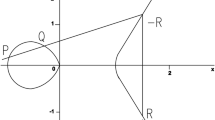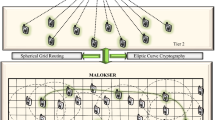Abstract
In this paper, we propose a new clustering, encryption and trust modeling based energy aware routing secured algorithm for performing secured data communication in Wireless Sensor Networks For this purpose, an Elliptic Curve Cryptography based encryption scheme is proposed in this work where the key generation scheme of Elliptic curve cryptography and the strength of the keys used in it for encryption are enhanced by pre-concatenation and post-concatenation of values obtained from the Euler’s phi function value and Gamma function values based on the user identifier values for ‘n’ different users. This proposed technique performs secured routing by encrypting the messages before they are routed to the destination through the network. In this scheme, only one pairing computation with a loop is necessary to encrypt a single message which is to be communicated to ‘n’ different receivers by forming ‘n’ different cipher texts using the proposed elliptic curve group theory based encryption algorithm. The proposed secured routing algorithm has been modeled in this work by performing the encryption of the plain text message before it is sent in the network. Moreover, this proposed system uses a trust model to check for any attempt by intermediate nodes for decrypting the encrypted messages during routing in order to enhance the security of communication. The proposed encryption scheme reduces the computation cost by computing the keys for all the receivers in one attempt. Performance analysis of this proposed scheme shows that computation time is for key formation, encryption and decryption are less in the proposed scheme when it is compared with the existing ECC based schemes for encryption and decryption. In addition, the secured routing algorithm proposed in this paper that uses the proposed encryption technique and trust modeling for enhancing the security of communication increases the packet delivery ratio, security and the overall network performance and it also decreases the delay and energy consumption by avoiding the security attacks efficiently.









Similar content being viewed by others
Availability of Data and Material
No such data and material are used in this work.
References
Gurumoorthi, E., & Ayyasamy, A. (2019). Cache agent based location aided routing protocol using direction for performance enhancement in VANET. Wireless Personal Communications, 109(2), 1195–1216.
Munuswamy Selvi, S. V. N., Kumar, S., Ganapathy, S., Ayyanar, A., Nehemiah, H. K., & Kannan, A. (2021). An energy efficient clustered gravitational and fuzzy based routing algorithm in WSNs. Wireless Personal Communications, 116(1), 61–90.
Sumathi, J., & Velusamy, R. L. (2021). A review on distributed cluster based routing approaches in mobile wireless sensor networks. Journal of Ambient Intelligence and Humanized Computing, 12(1), 835–849.
Selvakumar, B. D. L. S. K. (2021). Intelligent energy-aware and secured QoS routing protocol with dynamic mobility estimation for wireless sensor networks. Wireless Networks, 27(2), 1503–1514.
Jiang, X., Sun, C., Cao, L., Law, N.-F., & Loo, K. H. (2022). Semi-decentralized energy routing algorithm for minimum-loss transmission in community energy internet. International Journal of Electrical Power & Energy Systems, 135, 107547.
Diffie, W., & Hellman, M. (1976). New directions in cryptography. IEEE transactions on Information’s theory, 22(6), 644–654.
Silverman, G. H. (1985). The arithmetic of elliptic curves. Springer.
Lin, D., & Wang, Q. (2017). A game theory based energy efficient clustering routing protocol for WSNs. Wireless Networks, 23(4), 1101–1111.
Prithi, S., & Sumathi, S. (2021). Automata based hybrid PSO–GWO algorithm for secured energy efficient optimal routing in wireless sensor network. Wireless Personal Communications, 117(2), 545–559.
Vijayakumar, P., Bose, S., & Kannan, A. (2013). Centralized key distribution protocol using the greatest common divisor method. Computers & Mathematics with Applications, 65(9), 1360–1368.
Maheshwari, P., Sharma, A. K., & Verma, K. (2021). Energy efficient cluster based routing protocol for WSN using butterfly optimization algorithm and ant colony optimization. Ad-Hoc Networks, 110, 1–13.
Shafiq, M., Ashraf, H., Ullah, A., & Tahira, S. (2020). Systematic literature review on energy efficient routing schemes in WSN – A survey. Mobile Networks and Applications, 25, 882–895.
Murthy, S., Souza, R. J. D., & Varaprasad, G. (2012). Digital signature-based secure node disjoint multipath routing protocol for wireless sensor networks. IEEE Transactions on Sensors Journal, 12(10), 2941–2949.
Shamim Hossain, M., You, X., Xiao, W., Luc, J., & Song, E. (2019). QoS-oriented multimedia transmission using multipath routing. Future Generation Computer Systems, 99, 226–234.
Xiao, J., Liu, Y., Qin, H., Li, C., & Zhou, J. (2021). A novel QoS routing energy consumption optimization method based on clone adaptive whale optimization algorithm in IWSNs. Journal of Sensors, 2021, 1–17. https://doi.org/10.1155/2021/5579252
Logambigai, R., Ganapathy, S., & Kannan, A. (2018). Energy–efficient grid-based routing algorithm using intelligent fuzzy rules for wireless sensor networks. Computers & Electrical Engineering, 68, 62–75.
Ponguwala, M., & Rao, S. (2019). E2-SR: A novel energy-efficient secure routing scheme to protect MANET-IoT. IET Communications, 13(19), 3207–3216.
Maheswari, M., & Karthika, R. A. (2021). A novel QoS based secure unequal clustering protocol with intrusion detection system in wireless sensor networks. Wireless Personal Communications, 118(2), 1535–1557.
Heinzelman, W. R., Chandrakasan, A. P., Balakrishnan (2000). Energy-efficient communication protocol for wireless microsensor networks, Proceedings of IEEE 33rd annual Hawaii International Conference on System Sciences, Vol. 2, pp. 1–10.
Heinzelman, W. R., Chandrakasan, A. P., & Balakrishnan. (2002). An application specific protocol architecture for wireless sensor network. IEEE Transaction on Wireless Communication, 1(4), 660–670.
Younis, O., & Fahmy, S. (2004). HEED: A hybrid, energy-efficient, distributed clustering approach for ad hoc sensor networks. IEEE Transactions on Mobile Computing, 3(4), 366–379.
Rajendran, N., Jawahar, P. K., & Priyadarshini, R. (2019). Cross centric intrusion detection system for secure routing over black hole attacks in MANETs. Computer Communications, 148, 129–135.
Stallings, W. (2005). Cryptography and network security principles and practices. Prentice Hall.
Forouzan, A. (2015). Cryptography and network security. McGraw Hill Education.
Miller, V. S. (1986). Use of elliptic curves in cryptography. In Lecture Notes in Computer Sciences on Advances in cryptology- CRYPTO85. Berlin, Heidelberg: Springer-Verlag. 1986, pp.417–426. URLhttp://dl.acm.org/citation.cfm?id=18262.25413.
Geetha, R., Padmavathy, T., Thilagam, T., & Lallithasree, A. (2020). Tamilian cryptography: An efficient hybrid symmetric key encryption algorithm. Wireless Personal Communications, 112, 21–36.
Sangeetha, G., Vijayalakshmi, M., Ganapathy, S., & Kannan, A. (2020). An improved congestion-aware routing mechanism in sensor networks using fuzzy rule sets. Peer Peer Networking and Applications, 13(3), 890–904.
Koblitz, N. (1978). Elliptic curve cryptosystem. Mathematics of Computation, 48(177), 203–209.
Jr Hendrik, W. L. (1987). Factoring integers with elliptic curves. Annals of Mathematics, 126(2), 649–673.
Peyravian, M., Matyas, S. M., & Zunic, N. (1999). Decentralized group key management for secure multicast communications. Computer Communications, 22(13), 1183–1187.
Bill Hancock CISSP. (1999). Elliptical curve cryptography and standards for efficient cryptography group. Computers & Security, 18(1), 4–15.
Lin, Y.-L., & Hsu, C.-L. (2011). Secure key management scheme for dynamic hierarchical access control based on ECC. Journal of Systems and Software, 84(4), 679–685.
Fan, D., Meng, X. F., Wang, Y., Yang, X., Peng, X., He, W., Dong, G., & Chen, H. (2013). Asymmetric cryptosystem and software design based on two-step phase-shifting interferometry and elliptic curve algorithm. Optics Communications, 309, 50–56.
Vijayakumar, P., Bose, S., & Kannan, A. (2014). Chinese remainder theorem based centralised group key management for secure multicast communication. IET information Security, 8(3), 179–187.
Daghighi, B., Kiah, M. L. M., Shamshirband, S., Iqbal, S., & Asghari, P. (2015). Key management paradigm for mobile secure group communications: Issues, solutions, and challenges. Computer Communications, 72, 1–16.
Vijayakumar, P., Azees, M., Kannan, A., & Deborah, L. J. (2016). Dual authentication and key management techniques for secure data transmission in vehicular ad hoc networks. IEEE Transactions on Intelligent Transportation Systems, 17(4), 1015–1028.
Liu, Y., Liu, Y., Dong, M., Ota, K., & Liu, A. (2016). ActiveTrust: Secure and trustable routing in wireless sensor networks. IEEE Transactions on Information Forensics and Security, 11(9), 2013–2027.
Liu, Z., Huang, X., Hu, Z., Khan, M. K., Seo, H., & Zhou, L. (2017). On emerging family of elliptic curves to secure Internet of Things: ECC comes of age. IEEE Transactions on Dependable and Secure Computing, 14(3), 237–248.
Santhosh Kumar, S. V. N., & Palanichamy, Y. (2018). Energy efficient and secured distributed data dissemination using hop by hop authentication in WSN. Wireless Networks, 24(4), 1343–1360.
Kalidoss, T., Rajasekaran, L., Kanagasabai, K., Sannasi, G., & Kannan, A. (2020). QoS aware trust based routing algorithm for wireless sensor networks. Wireless Personal Communications, 110(4), 1637–1658.
Kumar, V., Kumar, R., & Pandey, S. K. (2020). A computationally efficient centralized group key distribution protocol for secure multicast communications based upon RSA public key cryptosystem. Journal of King Saud University - Computer and Information Sciences, 32(9), 1081–1094.
Wang, L., Tian, Y., Zhang, D., & Yanhua, Lu. (2019). Constant-round authenticated and dynamic group key agreement protocol for D2D group communications. Information Sciences, 503, 61–71.
Viswanathan, S., & Kannan, A. (2019). Elliptic key cryptography with beta gamma function for secure routing in wireless sensor networks. Wireless Networks, Springer Publication., 25(8), 4903–4914.
Sethuraman, P., Tamizharasan, P. S., & Arputharaj, K. (2019). Fuzzy genetic elliptic curve Diffie Hellman algorithm for secured communication in networks. Wireless Personal Communications, 105(3), 993–1007.
Selvi, M., Thangaramya, K., Ganapathy, S., Kulothungan, K., Nehemiah, H. K., & Kannan, A. (2019). An energy aware trust based secure routing algorithm for effective communication in wireless sensor networks. Wireless Personal Communications, 105(4), 1475–1490.
Prabhu Kavin, B., & Ganapathy, S. (2019). A secured storage and privacy-preserving model using CRT for providing security on cloud and IoT-based applications. Computer Networks, 151, 181–190.
Abbasinezhad-Mood, D., Ostad-Sharif, A., Nikooghadam, M., & Mazinani, S. M. (2020). A secure and efficient key establishment scheme for communications of smart meters and service providers in smart grid. IEEE Transactions on Industrial Informatics, 16(3), 1495–1502. https://doi.org/10.1109/TII.2019.2927512
Kurt, G. K., Khosroshahi, Y., Ozdemir, E., Tavakkoli, N., & Topal, O. A. (2020). A hybrid key generation and a verification scheme. IEEE Transactions on Industrial Informatics, 16(1), 703–714. https://doi.org/10.1109/TII.2019.2950465
Gharsallah, I., Smaoui, S., & Zarai, F. (2020). An efficient authentication and key agreement protocol for a group of vehicles devices in 5G cellular networks. IET Information Security, 14(1), 21–29.
Shin, S., & Kwon, T. (2020). A privacy-preserving authentication, authorization, and key agreement scheme for wireless sensor networks in 5G-integrated Internet of Things. IEEE Access, 8, 67555–67571. https://doi.org/10.1109/ACCESS.2020.2985719
Dang, T. K., Pham, C. D. M., & Nguyen, T. L. P. (2020). A pragmatic elliptic curve cryptography-based extension for energy-efficient device-to-device communications in smart cities. Sustainable Cities and Society, 56, 102097.
Elhoseny, M., Elminir, H., Riad, A., & Yuan, X. (2016). A secure data routing schema for WSN using elliptic curve cryptography and homomorphic encryption. Journal of King Saud University - Computer and Information Sciences, 28(3), 262–275.
Ahmed, A., Bakar, K. A., Channa, M. I., Haseeb, K., & Khan, A. W. (2016). A trust aware routing protocol for energy constrained wireless sensor network. Telecommunication Systems, 61(1), 123–140.
Mazinani, A., Mazinani, S. M., & Mirzaie, M. (2019). FMCR-CT: An energy-efficient fuzzy multi-cluster based routing with a constant threshold in wireless sensor network. Alexandria Engineering Journal, 58(1), 127–141.
Ayyasamy, A., & Venkatachalapathy, K. (2015). Context aware adaptive fuzzy based QoS routing scheme for streaming services over MANETs. Wireless Networks, 21(2), 421–430.
Beheshtiasl, A., & Ghaffari, A. (2019). Secure and trust-aware routing scheme in wireless sensor networks. Wireless Personal Communication, 107(4), 1799–1804.
Smart, Nigel P. (1999). The discrete logarithm on elliptic curves of trace one. Journal of cryptology, 12, 193–196.
Andrews, G. E. Askey, R. & Roy, R. (1999). Special Functions. In: Encyclopedia of mathematics and its application, Vol.71
Broker, R., & Stevenhagen, P. (2007). Efficient CM-construction of elliptic curves over finite field. Mathematics of Computation, 76(260), 2161–2179.
Funding
No funding is received for this work from anywhere.
Author information
Authors and Affiliations
Corresponding author
Ethics declarations
Conflicts of interest
There is no conflict of interests.
Additional information
Publisher's Note
Springer Nature remains neutral with regard to jurisdictional claims in published maps and institutional affiliations.
Rights and permissions
About this article
Cite this article
Viswanathan, S., Bhuvaneswaran, R.S., Ganapathy, S. et al. Euler Phi Function and Gamma Function Based Elliptic Curve Encryption for Secured Group Communication. Wireless Pers Commun 125, 421–451 (2022). https://doi.org/10.1007/s11277-022-09557-6
Accepted:
Published:
Issue Date:
DOI: https://doi.org/10.1007/s11277-022-09557-6




